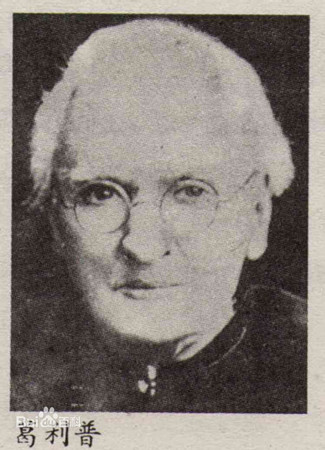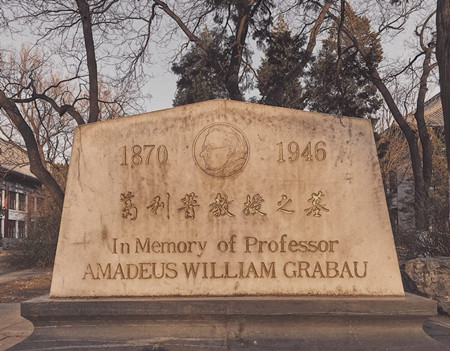Peking University, April 24, 2018: “What makes a university great is not the buildings but the scholars and masters it has”, said Mei Yiqi during his inauguration speech at Tsinghua University in 1931. The line has since then influenced Chinese higher education greatly, Beida included. When Beida was founded in 1898 (known as the Imperial University of Peking then), one of the greatest problems it had was the lack of capable teachers. Missionaries, scholars and professors from England, Germany, the US and many other countries came to China to help build the first modern institution for higher education. Their contribution is unique and unparalleled. Amadeus William Grabau is one of them.
The year 2009 marked the 100th anniversary of Beida Department of Geology. To celebrate the anniversary, the department published an article looking back at its 100-year development. The article mentions Amadeus William Grabau in particular, an American geology professor, who joined the department in 1920. “By joining the department, Grabau exerted a significant and far-fetching influence on both the education at the department and the communication between Chinese and Western geologists”.

The third from left (Group photo of graduation, Department of Geology, 1934)
Grabau was born in 1870 in a small Wisconsin town called Cedarburg. His father ministered to the German Lutheran community there. He finished his undergraduate study at MIT and got his doctorate at Harvard. His dissertation was “Phylogeny of Fusus and Its Allies”. In 1901, he started to teach at Columbia and left there in 1919. Despite his fame in China, he might not be so well-known in the US compared with his wife Mary Antin, the author of The Promised Land.
When he set foot in Shanghai in 1920, Grabau might never have thought that he was going to spend the rest of his life in China. In truth, he devoted the second half of his life to the geological education at Beida and cultivated outstanding geological talents who would later compose half of the academia of geology in China. Besides, he united the geological talents during his time, bridging the communication between scholars from China, England, France, Germany, the US, etc. Besides educating students, Grabau also continued his research in the fields of geology and paleontology. His most well-known works include Principles of Stratigraphy, Stratigraphy of China, Rhythm of the Ages and the posthumous The World We Live In, the latter three finished during his years in China.
At the beginning of the 20th century, geology was quite a new subject in China. Beida Department of Geology was established in 1909, marking the beginning of the geological education in China. Unfortunately, the department of geology saw only two students graduating in 1913. It was not until 1917 that it re-opened and welcomed its second class of students.
Besides, lack of faculty members also threatened the newly born department. Ding Wenjiang, a famous Chinese geologist and social activist who later became one of Grabau’s best friends, was appointed to take on the mission of finding teachers for the department. And it is for the two teachers that Ding recruited, namely Grabau and another young scholar Li Siguang, who brought the department of geology to rapid development and helped establish its fame worldwide in the next two decades.

Amadeus William Grabau
Grabau arrived in late October, 1920 and started to teach at Beida on November 3. According to The University Daily, the first class he was going to teach on that day was Paleontology Lab. Until 1926, Grabau offered 8 courses in total, ranging from Theory of Evolution, Advanced Stratigraphy to Paleontology and Fossil Study. Students showed great enthusiasm to Grabau’s courses as well. There were fifty students in his paleontology class, forty in historical geology and sixty in a newly opened comparative study course.
Grabau taught his students more than geological knowledge. He told his students that they were “pioneers in the development of this science in your country” and he wanted them to “search out and make known the geological structure and history of this vast country”. After noticing Chinese students’ “reliance upon authority, their predilection for book learning”, Grabau asked his students to put away all books and lecture notes and taught them to observe, to reason, to develop the power of independent judgment and self-reliance, “to wean them from undue reliance on authority”. He had faith not only in his students, but also in China: “In spite of all the present unrest and disorganization, this young republic has a great future, and we must help by giving the men who are to do the work of the future the sounded training possible.” He believed that American scholars’ efforts in this aspect would be a great part in “cementing the friendship between the two countries”.
However, Grabau also met with difficulties. In his letter to Ray Bassler, an American geologist, he said that “geological work in China is difficult…on account of the lack of good maps, the time consuming and fatiguing journeys before you reach the field—much of the area can only be reached on mule back…over atrocious roads or no roads at all…”. But still, he said that the fieldwork was “wonderful” because of the abundance of fossils he collected. In one expedition to Kaiping basin, he brought back forty boxes of fossils. No doubt, his years at Peking stimulated the scholar’s passion once again and motivated him to finish more than half of his whole lifetime’s publications. In 1924 and 1928, he published the two-volume Stratigraphy of China. Weng Wenhao, Grabau’s colleague and also a famous geologist, praised that the book “give[s] a clear and comprehensive history of the successive stages of the geological and paleontological evolution in this part of the world”.
Apart from in-class education, Grabau also contributed greatly to the mixing together of Chinese and Western scholars. In 1922, the Geological Society of China was founded, which was one of the earliest academic groups in China. Grabau was among the twenty-six charter members. What’s more, Grabau generously provided his residence at Peking as the meeting places for scholars and students of geology from different nations. Allan Mazur, Grabau’s biographer who wrote “Amadeus Grabau in China: 1920-1946”, comments that Grabau “was the glue that held Chinese and Western scientists together” and that Grabau “was a pillar of all these associations”. Grabau’s sister Adele, who came to China to look after Grabau in 1934, also observed that “Amadeus…just sits somewhere in a room and at once all gather around him”. Sven Hedin, a Swedish geographer and Grabau’s friend, gave a detailed description of dinner at Grabau’s house: “the guests frequently formed small academic groups to discuss scientific problems. Grabau’s home became a focus, a salon, for the academic circles in Peking, and his hospitality knew no bounds”.
Grabau’s influence was not limited to his students or colleagues. From December, 1920 to December, 1921, Grabau held a series of public speeches on “The Earth and the Evolution of Its Creatures”. It happened that Bertrand A. W. Russel, the English philosopher, was lecturing around China at that time as well. The two scholars’ speeches were so popular that they were published in The University Daily and other newspapers. Shen Bao (also known as Shanghai News) commented that among the foreign lecturers in Peking, Russel and Grabau were the most popular.
While playing a rather active role in the geology academia, Grabau had always been troubled with arthritis and had to use crutches. His sister Adele recorded that when Grabau left the house, he would “have both legs bandaged from foot to knee. One leg has an open sore like a dollar size—not running but just does not form skin over it”. The illness “hurts him much” that when he could not walk to the classroom he would ask his students to come to his house and continue his teaching. Also, it was a common thing for teachers to get their salaries late at that time. There was one time when teachers did not receive their salaries until six months later. Despite the situation, Grabau would continue his teaching at home while the campus was closed for teachers’ protests.
Grabau’s last few years were far from comfortable. He had been interned by the Japanese army in a vacated British embassy in the Legation Quarter since 1943. And it is during the years of internment from 1943 until his release in 1945 that Grabau’s health deteriorated fast for lack of medical support. At that time, he was “invalided by age, severe arthritis, broken hip-bone, and other ailments. He is without funds or property, and is badly in need of financial assistance”. When his students rescued him out of the compound, his first words were: “Are you my students?” A few months after his release, Grabau passed away.
In 1947, the Geological Society of China published volume 27 of the Bulletin of the Geological Society of China in memorial of Grabau. Zhang Hongzhao wrote the following poem for his friend Grabau, who contributed the second half of his life to the geological education and spread in China:
A mighty mountain has been cleft in twain
So passed away a great man from our throng
His worthy work forever would remain
To vie with moon and stars and last as long
The world just tast'd the hard-earn'd cup of peace
He passed away, a life without regret;
For twenty years he lived a true Chinese
And in this land his soul will linger yet
Grabau was buried at the campus of Beida, “a simple grave, but obviously regularly and lovingly tended”.
The grave of Professor Amadeus William Grabau (Photo credit to Zhang Yixin)
Sources:
潘云唐. “葛利普——中国地质科学工作者的良师益友.” 中国科技史杂志, no. 3, 1982, pp. 22-30.
孙承晟. “‘他乡桃李发新枝’:葛利普与北京大学地质学系.” 自然科学史研究, vol. 35, no. 3, 2016, pp. 341-357.
夏红卫,and北京大学国际合作部. 北大洋先生. 北京大学出版社,北京,2012.
Mazur, Allan. “Amadeus Grabau in China: 1920–1946.” Carbonates & Evaporites 21.1(2006):51-93.
Reported by: Yan Shengnan
Edited by: Xu Liangdi


